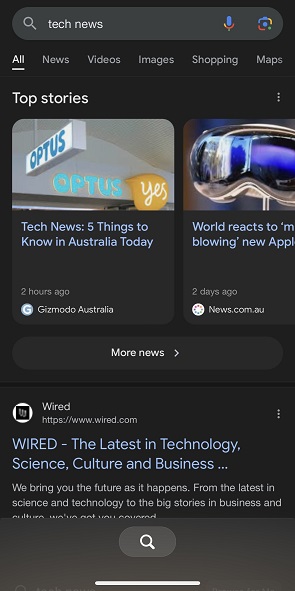Arc Search is a browser that wants you to focus on the experience of surfing the web because it knows the more you pay attention, the more you realise just how poor that everyday experience really is.
Unfortunately, it also makes you see how this new AI-powered browser doesn’t quite hit the mark.
Arc Search is made by the aptly named Browser Company, a US-based firm trying to redesign web browsing for the 2020s.
That means a slick, user-friendly design, plenty of emojis, and – of course – generative AI.
A blog post about the app claims the app “clears the clutter” by blocking ads, trackers, and pop ups – including those irritating GDPR cookie prompts (note: I've still seen plenty pop up during my testing).
For the last week, I’ve had the Arc Search app in the centre of my iPhone home screen. Currently, it’s only available on Mac and iOS but Windows is coming soon.
I wanted to try using Arc for its AI search function which made a small splash when it launched late last month.
When you hit ‘browse for me’ on your search, a splash screen comes up to say the browser is scanning six web pages before delivering the results in a page that has a carousel of images at the top followed by a series of headings and sentences punctuated with emojis.
There’s nothing particularly new about what Arc Search does here. Paid versions of ChatGPT can scan the web for results, as can Google Bard (which may soon be rebranded as Gemini) and Microsoft Bing.
Where Arc stands out is in its user-first design that, in certain ways, makes Google feel particularly outdated.
🔎 Introducing Arc Search
— The Browser Company (@browsercompany) January 29, 2024
The fastest way to search on mobile
Now available in the App Store! pic.twitter.com/gZL6Zdhvtl
Google Search is a legacy product with nearly 30 years of features jammed into it: boxes pulled from Wikipedia, short summaries, highlighted snippets, drop down menus, maps, videos, and – most importantly for Google – ads.
By being much of the world’s default search engine, Google has spent the last 30 years shaping the internet.
Websites are explicitly optimised for Google’s search algorithms, spinning up a whole content industry that wants nothing more than to reach the top of Google Search results and deliver ad-laden pages to millions of internet users.
But when ChatGPT arrived over 12 months ago, it seemed to put an end to the idea that a search engine just gives you a simple set of links to other websites.
Don’t forget the links
When you type in ‘tech news’ to Arc Search and hit ‘browse for me’ it tries to offer a direct set of result by curating a list of headlines to help you see quickly see what was in the news.
“Latest Technology News”, reads the main header. Underneath are some A-generated headlines with a brief sentence offering a bit more detail.
It’s meant to be neat, modern, and give you a quick glance of what you want to see.

Arc Search can generate a page of search results. But where are the links?
When you simply hit ‘go’ on the same search terms, Arc takes you to Google which provides a nice contrast.
Even without the ads (automatically blocked in Arc, but you can change it in settings), compared with the Arc Search AI, Google feels cluttered.

At a glance, Google doesn't give you much at all.
Past the search bar, you see a carousel of ‘top stories’ to sift through but because the headlines are copied verbatim from the original sites – not re-written by a language model – they may deliberately withhold information about the story.
This is by design: news sites, like much of the Google-centric web, need clicks to sell ads or subscriptions. Headlines that have a curiosity gap (AKA clickbait) help drive traffic to the site.
It’s a minor problem, but shows how AI might fundamentally shift how the web works by incentivising different types of content – especially if it doesn’t need to send you to another site to find what you want.
Sadly for Arc Search, this last assumption is where it falls down at the moment because the ‘browse for me’ feature falls down beyond a cursory glance.
Interested in a story about ransomware payments hitting a record in 2023? Or do you want to learn more about an AI Clickbait Kingpin. Bad luck, Arc Search doesn’t have a direct link.
It’s even worse for things like restaurant recommendations.
Arc Search’s AI feature does create a page with a nice list of restaurant names along with short descriptions – “offers Italian street food and is a favourite for cheap eats” – but no way to directly click on a restaurant go to its website.
To do that, you have to scroll down to the list of six websites, like Tripadvisor, from which Arc Search pulled its results at which point you might as well have used Google.
Certainly this isn’t an insurmountable problem.
Microsoft Copilot has hyperlinks inside its results for ‘tech news’, which has an unsurprising tendency to include links from its partnered news sites.
But it’s a shame that, at least in its current form, a browsing app focused on user experience failed to recognise that surfing the web is still all about clicking links.










